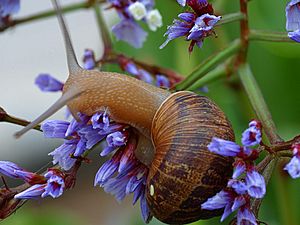Helix (genus) facts for kids
Quick facts for kids Helix |
|
|---|---|
 |
|
| Garden snail (Helix aspersa) on Limonium | |
| Scientific classification | |
| Kingdom: | |
| Phylum: | |
| Class: | |
| (unranked): |
clade Eupulmonata
|
| Superfamily: |
Helicoidea
|
| Family: | |
| Genus: |
Helix
Linnaeus, 1758
|
Helix is a group, or genus, of large snails that live on land and breathe air. These snails are a type of mollusc called a gastropod.
Scientists know about Helix snails from a long time ago, starting in the Oligocene period. This means they have been around for millions of years! You can find these snails naturally in Europe and around the Mediterranean Sea.
Some of the most famous Helix species are the common garden snail (Helix aspersa) and the Roman snail (Helix pomatia). The Roman snail is also known as the Burgundy snail or edible snail. People sometimes eat H. pomatia and other Helix species as a dish called escargot.
Helix snails have traveled to many parts of the world. Some, especially the garden snail (H. aspersa), have become pests in gardens.
Contents
About Helix Snails
Helix snails like places that are cool and damp. They can dry out easily, so they are most active at night or after it rains. When the weather is not good, a snail will stay inside its shell. They often hide under rocks or in other safe spots to avoid predators. In dry places, snails will gather near water, even from places like air conditioner outlets.
What Helix Snails Eat
The common garden snail (Helix aspersa) is a herbivore, which means it eats plants. These snails can digest many types of plants, including carrots and lettuce. They have special bacteria in their bodies that help them digest food. These helpful bacteria break down tough plant parts like cellulose into simple sugars.
How Helix Snails Reproduce
Snails in the Helix group have a unique way of mating. During this time, they use something called a love dart. This is a sharp, calcium structure that they use to help with reproduction.
Images for kids
See also
 In Spanish: Helix (molusco) para niños
In Spanish: Helix (molusco) para niños



